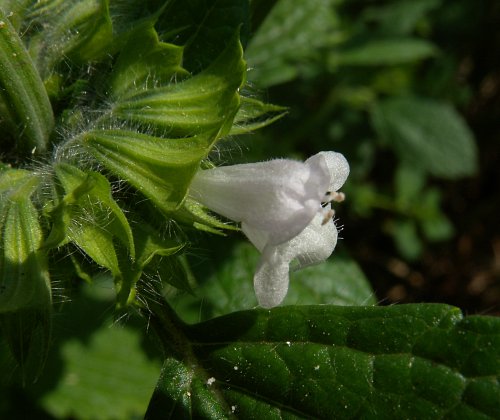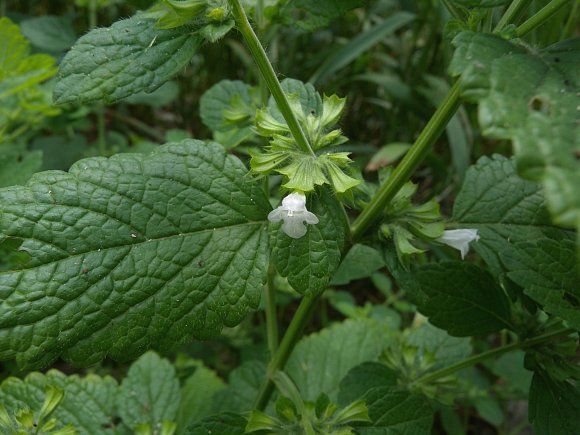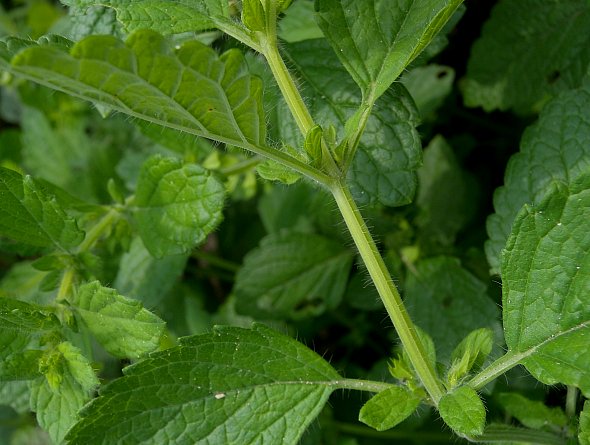
Clusters of 2-10 flowers develop from the axils of the upper leaves on short pedicels that are 1-5 mm. in length; there are no terminal clusters of flowers. Individual flowers are 8-13 mm. in length with corollas that are longer than their calyces. Each flower has a white corolla, a light green calyx with 5 teeth, 4 stamens, and a 4-parted ovary with single style that is cleft toward its tip. Each corolla is tubular-campanulate (tubular and bell-shaped), dividing into a hood-like upper lip and a 3-lobed lower lip. The calyx is angular and trumpet-shaped with 3 smaller upper teeth and 2 larger lower teeth; it is finely hairy along its veins and 4-8 mm. in length. The blooming period occurs from late spring to late summer, lasting 1½-3 months. Usually, only a few flowers are in bloom at the same time on individual plants. Afterwards, the flowers are replaced by small nutlets (4 nutlets per flower) that are lanceoloid-ellipsoid and smooth. The root system is fibrous and rhizomatous.
Cultivation: The preference is full to partial sun, moist to mesic conditions, and fertile soil containing loam. This plant is easy to cultivate once it becomes established.

Range & Habitat: Lemon Balm rarely naturalizes in Illinois (see Distribution Map), where it is not native. This plant was introduced from Europe into North America as a culinary and medicinal herb. It is still cultivated in gardens and sometimes it is grown commercially. Escaped plants are typically found in such habitats as thickets, fence rows, abandoned homesites, vacant lots, areas along roadsides, banks of ponds, floodplain areas along drainage canals, and waste areas. Areas with a history of disturbance are preferred. Lemon Balm is especially likely to naturalize in urban and suburban areas, as this is where most cultivated plants occur.
Faunal Associations: Little Information about floral-faunal relationships for this plant is available for North America. The flowers are used by bees as a source of nectar.
Photographic Location: Floodplain area of a drainage canal in Champaign, Illinois.

Comments: Lemon Balm (Melissa officinalis) is a fairly typical example of plants in the Mint family. Its foliage usually has a mild lemon fragrance, otherwise this plant is rather similar to several other species in the Mint family with small whitish flowers. Unlike some of these species, such as Nepeta cataria (Catnip) and Ocimum basilicum (Basil), Lemon Balm lacks terminal clusters of flowers. Unlike Chaiturus marrubiastrum and most Lycopus spp. (Bugleweeds), it also has broad-based leaves that are less than 3 times as long as they are across. Lemon Balm can be distinguished from the similar Marrubium vulgare (Common Horehound) by the presence of 5 teeth on its calyces, while the latter species has calyces with 10 teeth. According to Wikipedia, Lemon Balm has been used traditionally to calm nervous tension, insomnia, and other conditions; apparently there is some scientific evidence that it really does have some anti-anxiety and sedative effects. In addition, Lemon Balm has been investigated in the medical community as a possible treatment for Alzheimer's disease and for cold sores of the herpes simplex virus. The leaves are used as an ingredient in herbal teas and salads, where they may have beneficial anti-oxidant effects. Many different cultivars of Lemon Balm are now available that vary in the fragrance of their foliage and other characteristics.